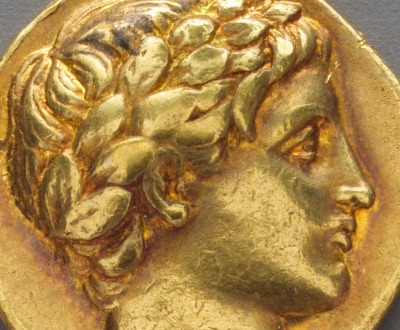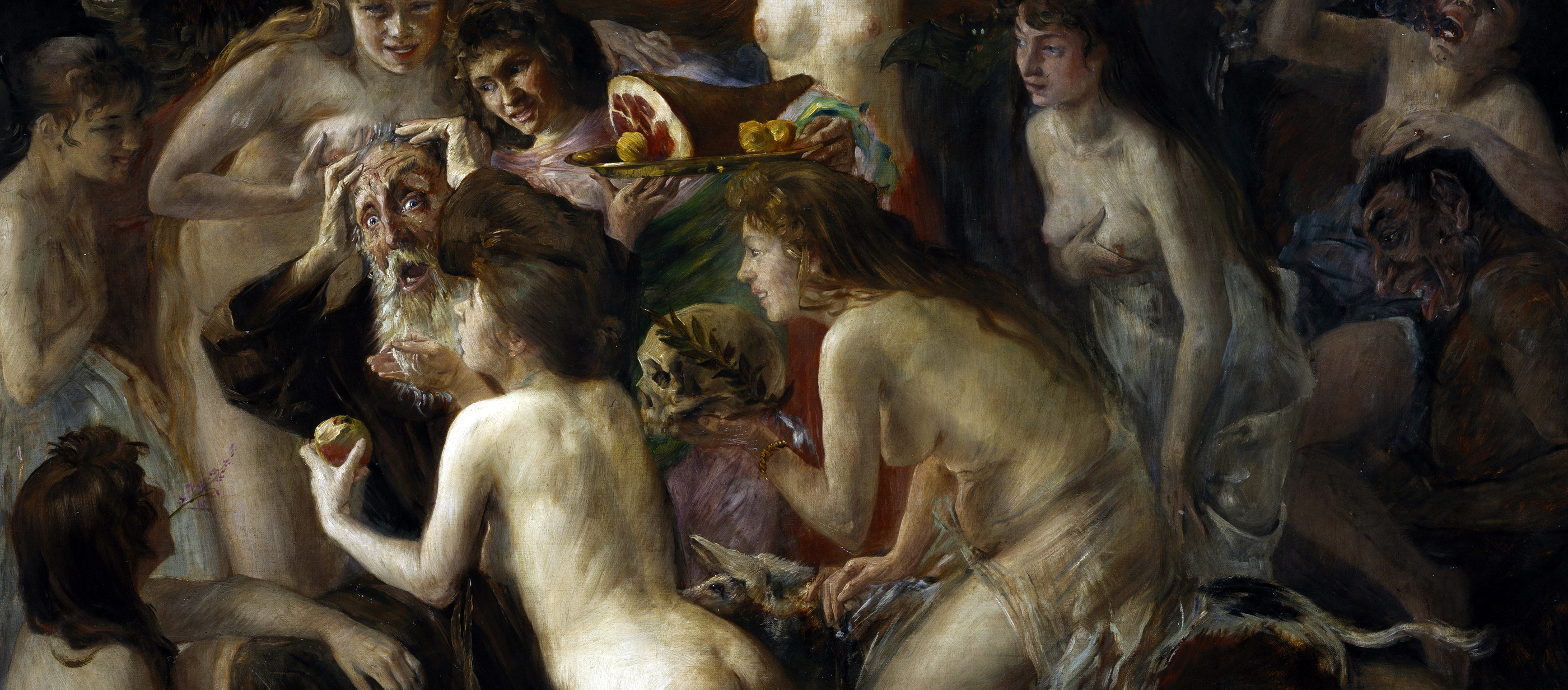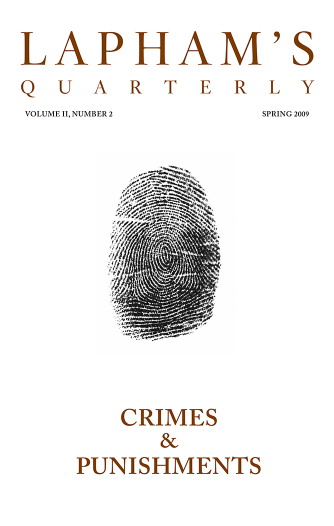And, after all, what is a lie? ’Tis but the truth in masquerade.
—Lord Byron, 1822We Buy Broken Gold
Why would a wealthy diamond merchant in a three-thousand-dollar suit want to cheat me out of a hundred bucks’ worth of gold?
By Clancy Martin

Early Hellenistic gold stater, c. 323–315 [small_cap]bc[/small_cap]. The Metropolitan Museum of Art, Gift of J. Pierpont Morgan, 1905.
Audio brought to you by Curio, a Lapham’s Quarterly partner
My Uncle Pat claims the Martin family fortune has its origins in a World War I gold scam. I won’t apologize for this because I never saw a nickel of the family money. It was squandered by my father on Florida real-estate deals and my other uncle’s failed plan to buy a majority stake in Hudson’s Bay Company, Canada’s chain of department stores. After the scheme collapsed, this uncle died suddenly, though he somehow left a sizable chunk of money to his family. My Winnipeg cousins thus grew up rich: one of them raised Arabian horses and another was briefly Canadian ambassador to Thailand. I grew up in a rented three-bedroom house on a lower-middle-class street near the river in Calgary, Alberta, one of ten kids: my mother had divorced my father and, with the common sense characteristic of the family, married a man with seven children of his own and a failing business.
The money my father and uncles inherited wasn’t directly from the gold scheme: it was in the form of Martin Paper Products, Ltd., the largest corrugated-box company in Canada. But as my uncle Pat recently told the story, “The company all started with your great- grandfather and his brother in the First World War. You see, they were short of dentists, and the British and French thought Canadians understood teeth. Canadians have excellent teeth. They were looking for Canadians to help with the troops, you know, pulling cavities.”
“They were dentists?” I asked.
“No. But your great-grandfather saw the angle and set himself up as a tooth puller. He and his brother took all the gold and silver fillings they could get. They pulled every tooth they could, as long as it was worth something. After the war they came back with a small fortune in gold and silver. And that was the seed money for the box company.”
My father never denied the genealogy. I think he took a certain pride in it. “The Rockefellers, the Mellons, the Hiltons, all the great family fortunes started out with con men,” he’d reassure me, as though we belonged in and were justified by that company. “Nobody makes real scratch out of nothing without bending a few rules.”
I came by my own dishonest trade honestly. By the time I was sixteen, I had been kicked out of high school three or four times—I never managed to graduate—and my mother, fed up, sent me down to Texas to live with my older brother, who had recently been released from prison. He was briefly Calgary’s most successful cocaine importer, before getting busted and sent off to Spy Hill, and he had found employment as a sales manager for a hugely successful jewelry store owned by a brilliant, wildly charismatic man named Ronnie Cooper.
I’ve heard stories about old Texas coin shops that sold counterfeit collections to oil millionaires and Mexican construction magnates. These shops used all the old tricks that no longer work: blowing cigar smoke onto silver coins in paper bags to make them look aged, filing and restamping coins with rare dates, and sealing coins in plastic squares so they could be sold as uncirculated. They would assemble a team—a security salesman, say, a corrupt appraiser, and an insurance guy—and they’d sell the coins, overappraise them, provide the security system to guard them, and then steal them back before anyone was the wiser.

Dear Mind Powers Work Our Leader, by Mike Leavitt, 2013. Courtesy the artist and Jonathan LeVine Gallery.
Ronnie was an innovator in this world. Around 1980, he opened a coin shop on the corner of Houston and Sixth in downtown Fort Worth, calling it Fort Worth Gold and Silver Exchange. Right about when he opened his shop, there was a rally in metal prices—gold and silver tripled in price between 1978 and 1980. Ronnie, who was already an expert in bullion, realized there was an even better way to make quick cash: buying gold and silver from the public. Ronnie’s entry into the gold- and silver-buying business came just as the Hunt brothers, from Dallas, nearly succeeded in cornering the market on silver, before they went bankrupt. The news was full of talk about the scarcity of gold and silver and the certainty that precious metals were the only sure-fire get-rich-quick investment. Which, strange though it is, actually makes the average man want to sell his silver and gold.
Ronnie was running full-page “We’ll Pay Cash for Your Old Gold and Silver” ads in the Fort Worth Star-Telegram and the Dallas Morning News, and people drove from all over the metroplex to sell their jewelry. By the time I arrived at the store, we often had lines of thirty, forty, fifty people waiting outside before opening to get to the “buy counter.” Ronnie’s great success was that, once he made a little money from the “buys”—as they’re still called in the industry today—he expanded his coin shop into a full-fledged jewelry store. He added cowhide chairs and brass rails and crystal chandeliers and walnut-paneled walls; showcases stuffed with Rolexes, diamond tennis bracelets, giant rubies, sapphires, emeralds, and pearls. He also had tiaras, rainbow-tourmaline necklaces, and enormous South Sea pearls. Almost all of it was on consignment from jewelry wholesalers and counterfeiters—our counterfeit but solid-eighteen-karat-gold Rolexes were handmade in Brazil. Yes, he was selling a lot of luxury jewelry as well: along with the metals rally, Texas was enjoying an oil boom. But the real money was always in the buys—I’ll explain why in a moment—and the brilliance of Ronnie Cooper’s style was that the luxury jewelers at that time considered themselves morally and socially superior to the practice of buying jewelry from the public (discreetly brokering the private estates of well-established clients was another matter, of course). Ronnie knew the real money was in cheap chains and college rings and old wedding bands, and he understood that the Average Joe didn’t want to walk into a grubby pawnshop to sell his gold: he wanted to be treated with respect. As soon as you walked into Fort Worth Gold and Silver Exchange and were greeted by one of the beautiful twenty-year-old hostesses who worked part-time at our store while going to college at Texas Christian University only a few miles away, you knew you were going to get the best price for your jewelry. And all were welcome: a homeless guy walking into the store with a paper bag full of gold wedding bands was treated exactly the same as a newly divorced Texas socialite wanting to sell her two-carat D Flawless round. They took the same brass number off the mahogany table at the entrance, they waited on the same ornately patterned green-and-gold carpet to be called to the counter; they were offered the same champagne glass of Coca-Cola or sparkling water with lemon.
When they hired you at Fort Worth Gold, for the first month you vacuumed the carpets, changed the ashtrays, restocked the box room, and learned how to steam clean a customer’s jewelry while he or she waited. After you had the flavor of the place, they put you on the buy counter. And this, I realized much later when I ran a store of my own, was perhaps the most ingenious trick in Ronnie’s bag: because the young men and women working the buys were innocents, brand-new to the business, and because they had to get their prices from the old experts who worked desks in the back, we made our buy offers with a sincerity, trustworthiness, and enthusiasm that could never be duplicated by even the cleverest old diamond man. We were too young, too dumb, and too smartly dressed to cheat anyone.
I will never forget the first time I realized we were ripping people off. It’s the one and only time in my life that my older brother, a very gentle person by nature, swore at me. A pretty young woman, maybe twenty-three at the oldest, with one baby in her arm and another in a stroller, had been waiting about an hour, and I drew her number. When she came to the counter I was already sick to my stomach. She wanted to sell her diamond engagement ring and her gold wedding band. I had been taught the trick of how to buy gold. I could have weighed her ring on a gram scale and offered her that price immediately, but I knew you always bid on the biggest item first, because then the smaller offers for cheaper items feel less important, like small change.
But I also knew to test her wedding band before doing anything. The band was stamped fourteen-karat gold and I knew it was real. Still, I tested it for her benefit. The authentication of a customer’s gold makes them both nervous—could it be fake?—and then, when it tests out, puts them at ease: see, my stuff is real and he’s smart enough to prove it. I took one of the wooden boxes that held our gold-test kits from underneath the counter and rubbed a stripe of yellow metal onto the black slate testing stone. I took a drop from the ten-karat acid bottle, the fourteen-karat bottle, the eighteen-karat bottle. The gold disappeared under the eighteen-karat acid.
“See that? Fourteen karat, just like it’s stamped. That’s good.”
“Well, I guess he didn’t lie about everything,” she said, and smiled.
“This won’t take long,” I said, though I knew the longer she had to wait the more likely she was to take our offer. I was supposed to make the prospect of suffering through this process a second time as unbearable to her as possible.
I looked at her round brilliant-cut diamond. I knew enough to see that it was over a carat and, though it hadn’t been cleaned in a while, it was good quality.
“I’ll have to show this to our diamond man,” I told her.
“Could he come out here?” she asked me. “I heard you shouldn’t let your diamond out of your sight.”
This was a bold thing to say, and I liked her even better. She was right, too. I gestured to the crowd in the store. “You don’t have to worry here,” I said. “I’ll just be a minute. He’s very busy, and he doesn’t leave his desk. You can hang onto your wedding band for now. Here, you can weigh it for me, if you like,” I said, and handed her an electronic gram scale. Another trick: if the customer is involved in the process, she feels more comfortable with the result.
I took the ring in back and showed it to our diamond man. “Hmm,” he said. “Go put this one in the ultrasound and then give it a good steam. Bring it right back.” After I’d steamed it, it was blazing. It must have been a family diamond.
“This is a diamond. This is a seven-thousand-dollar stone, our cost,” the diamond man said. “Offer her two thousand. Buy it, Clancy. Don’t let her walk. I can dump it today for five grand, or we can put it in the case for ten.”
Well, that’s not too bad, I thought. She looked like two thousand plus fifty bucks or so for the wedding band would make her happy. Then my brother came around the corner.
“What’s that you’re buying?” he said.
“It’s D or E color, VVS,” the diamond man said. “Carat and a quarter easy, maybe a carat and a half. I told him two grand.”
“No, no, no,” my brother said. “Have you seen the girl?” He pointed through our one-way glass mirrors onto the showroom floor. “She’s desperate.” He took the ring from me, rubbed it thoroughly in an ashtray, looked at it, rubbed it again, blew on it, and gave it back to me. Just like the old cigar-smoke trick with the counterfeit coins. “Five hundred,” he said. “Not a dollar more.”
I went back out onto the floor. I spoke to the woman in a hushed tone, and quickly. “Listen,” I said. “All I can offer you is five hundred dollars.”
“Five hundred?” she almost shouted. “Five hundred? I thought I would get at least a thousand.”
“You can get two thousand, maybe three,” I whispered to her. “Just a couple blocks up from here, there’s a place called Rubinstein’s. They’re very honest guys. They won’t pay you what it’s worth—nobody can, that’s not how this works—but they’ll pay more than anyone else.”
Somehow I managed to calm her down and hustle her out of the store. But when I walked into the back my brother caught me by the shoulder and spun me around. He was shaking with rage.
“You little son of a bitch,” he said. “I heard everything you told her.”
I started to lie.
“Don’t even try it. This business is built on the buys. Without the buys we can’t survive. That’s your paycheck and my paycheck. We could have turned a seven-thousand-dollar profit on that one buy.”
He was right, of course. Even when we ran our own stores and I had to make a half-million-dollar payroll every month, I never learned how to go for the throat on the buys. It wasn’t out of virtue, it was just sadness or cowardice. It was always too easy to see myself in the same pathetic situation.
This story might strike you as scandalous, but the truth of the matter is the gold-and-diamond-buying scam artists of my generation were small potatoes. In the early twentieth century the astonishing Armand Hammer practiced jewelry scams no one would dream of attempting today, counterfeiting Fabergé eggs that he then promoted with “newsletters” and “editorial reviews,” written by “independent experts” who were all in fact pseudonyms for Armand Hammer. He and many others like him sold white gold as platinum and silver as white gold, and stamped the metal with fake hallmarks; he held museum showings of “rare Russian artifacts” that he’d had mass-produced in Europe; he sold garnets as rubies, topazes as sapphires. When he got out of the jewelry business and became one of the most powerful oil men in the country it was because he realized the scams he could pull in the oil business paid a lot better than those in the jewelry business.
We can’t all be Armand Hammer, but here’s how a simple gold buy ought to be done, and is done today in jewelry stores (these days almost all jewelry stores buy gold and silver, even the oldest and most respected retailers), pawnshops, and independent “gold buyers.” The key is to talk rapidly but with complete confidence—like a man too busy to waste either his own time or the seller’s—and to be quicker than a stenographer or a magician on the calculator.

Temptation of St. Anthony, by Lovis Corinth, 1897.
I’ll tell you how it’s done. Let’s say you have a fourteen-karat gold ring that weighs fifteen grams, or about half an ounce, and gold is at one thousand dollars an ounce. First you weigh it and show the customer that it’s fifteen grams. Then you take the price of an ounce of gold and divide it by thirty-one to get a gram price for pure.
“Now we multiply that by fourteen for fourteen karat and divide it by twenty-four for twenty-four karat, which is what it would be if it were 100 percent gold,” you explain to the seller. “That gives us the price for your fourteen-karat gold. Multiply that by fifteen, for fifteen grams. Now, fourteen karat is 56 percent gold and 44 percent base metal, which burns off at the smelter, so we multiply that by 0.56. Finally, we deduct 10 percent for the smelter, and 15 percent for my profit. Most gold buyers will charge you 20 or 25 percent, which is a reasonable profit margin, but we do such high quantity of gold-buying here that we can afford very low margins. That gives us a final figure of…”
You get the picture. The customer’s ring is worth $280 in real gold value. But you just offered $120, with a seemingly sound mathematical justification. And you’ve left yourself plenty of wiggle room if they want to haggle your profit down from 15 percent to 10 percent or even 7.5 percent. The real key to this scam is that you’ve deducted for the impurity of fourteen karat not once but twice: first, when you calculated the per-gram price and again when you “deduct for the base metal.” Furthermore, your smelter will charge you at most 5 percent—often less, depending on the quantity—and if it’s a nice piece you’ll never melt it down anyway. You’ll send it to your jeweler to make it look brand-new and put it in the showcase for retail. The key, as with my diamond buy back at Fort Worth Gold, is not to let them leave your office. And you do that by staring them in the eye and lying: “No one will offer you a better price. That’s the reason you’re here. Everybody knows we pay the highest.” Hold the customer’s gaze until they look away. Push their jewelry toward them, as though you really don’t want to buy it. Ninety-nine times out of a hundred—especially if you have a luxurious, busy store—your customer will wilt. The fact is, they’re already weakened: that’s what they’re doing in your store in the first place. They need the money. It’s not quite stealing gold fillings out of the pulled teeth of weary soldiers, but it’s the same principle. Use your expertise to exploit the weakness of someone who doesn’t know any better, and do it in a situation in which he believes he has reason to trust you. Why would a wealthy diamond merchant in a three-thousand-dollar suit want to cheat me out of a hundred bucks’ worth of gold?
I’ve been out of the jewelry business for years now, and I don’t pay attention to the price of precious metals like I used to. But we’ve just been through another gold-and-silver boom, and this time around, it’s not only jewelers and pawn dealers who’ve caught on to the scam. I live on the poor, black side of Kansas City, Missouri, and for this reason get a lot of different varieties of those “Quick Easy Cash” postcards in the mail. Usually these are from payday loan companies, pawnshops, high-interest advance-tax-refund services, or people offering a same-day purchase for your car or home. But lately I’ve noticed that a lot of the “car-title loan” and other similar businesses are dividing their glossy cards in two, with half of the card offering their traditional service—itself always an outrageous scam—and the other advertising “We Buy Broken Gold!” or “Cash for your Gold and Silver!” I’ve even wandered into half a dozen of these austere, dirty places with their long paper forms and their smudged, bulletproof Plexiglas windows to see what they pay for gold. It’s funny: their math works out about the same as ours did, but there’s no David Copperfield, no Wizard of Oz operating pulleys and levers from behind a silk purple curtain. It’s just, “This is what we pay,” and a kind of grudging refusal to return your ring when you demand it back. They stall you, weigh it a second time, “show it to the manager”: they know that much. But there’s no sex, no salesmanship. They’re just playing the numbers, catching the desperate ones and letting the others go.
If you steal, do not steal too much at a time. You may be arrested. Steal cleverly, little by little.
—Mobutu Sese Seko, 1991It may be of comfort to the reader that for centuries it was not the buyer but the seller of gold and other precious metals who, like Armand Hammer, was the scam artist in these transactions. When Archimedes yelled “Eureka” and jumped from his bathtub, it was because he realized how to determine whether or not the king’s crown was made of pure gold or merely cut with silver. The tradition of biting a gold or silver coin arose for the same reason, and the scam is still being played on even the most sophisticated jewelers.
Back when I was still in the business, two beautiful young women in tight T-shirts and denim shorts came in to sell us several princess-cut diamonds. We paid five hundred dollars a stone—a fair price for diamonds that would have cost us a lot more wholesale. But a few minutes after they left the store, we forgot about their T-shirts and more carefully inspected the diamonds. We quickly saw the telltale rainbow in each stone that indicated they had been laser-drilled and filled with a glassy substance that disguises imperfections. Over the course of the week we heard that an international gang was hiring strippers to sell the same diamonds to jewelers all over the state. It’s an unregulated industry, requiring a high degree of knowledge and often involving large sums of money. And unlike the collecting of art or stamps or rugs or Song dynasty tea bowls, it’s a hugely popular business with no barriers to entry for the buyer and few for the seller. So, like the car business before titles and vehicle-identification numbers and reliable odometers and services to check a vehicle’s history, it’s rampant with fraud. And as the science of diamond and gem enhancement and synthesis advances, it is rapidly becoming impossible—and perhaps irrelevant?—to distinguish between real and fake. With the right kind of radiation bombing, lead can now be transformed into gold, meaning the alchemist’s greatest challenge has been met. The process is still more expensive than mining gold, but it won’t always be.
To me, this is the lesson of every scam: at a certain point, it becomes like the discouraged, bored, cynical minimum-wage worker buying gold from behind a Plexiglas window, or a scientist growing diamonds in a lab. Once perfected, it’s no longer a scam at all. In his heyday, there was something beautiful about Ronnie Cooper—who eventually went to federal prison for selling fake Rolexes, among other shenanigans—that has now disappeared forever from the gold-buying business. I’m still glad I told that young mother to take her surprisingly valuable diamond out of our store and up the street. But I like to think of Ronnie as he was back in the wild, heady 1980s, when I was sixteen and he was in his thirties, and he was a little bit like Paul Newman in The Sting, with that dangerous, seductive, irrepressible optimism and unabashed love of winning that insists a hustler earns whatever he’s smart enough to swindle, and a mark loses whatever he’s dumb enough to risk.




